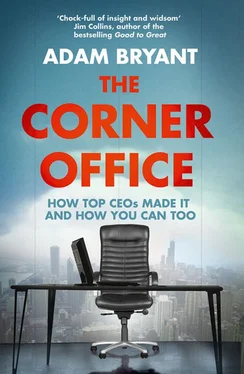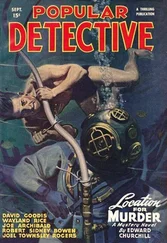Chapter 1
PASSIONATE CURIOSITY
Imagine onehundred people working in a large company. They’re roughly the same age, around thirty-five. They’re all vice presidents and share many of the same qualities that got them where they are. They’re smart, collegial, and hardworking. They consider themselves team players. They have positive attitudes and they’re good communicators. They’re conscientious about their jobs. They have integrity.
If everyone shares these qualities, what is going to determine who gets the next promotion? Who is going to move up not just one level, but the one after that, and the one after that? As they move up near the peak of their companies and the ranks thin out, the competition for the top spots is even tougher. Who will land the jobs that report directly to the CEO? What will set them apart from the crowd? When it’s time for the CEO to move on, who will get the nod from the board to move into the corner office?
In other words, what does it take to lead an organization – whether it’s an athletic team, a nonprofit, a start-up, or a multinational corporation? What, at the end of the day, are the keys, the x-factors, to achieving the highest levels of success?
Interviews with CEOs and other leading executives point to five essentials for success – qualities that most of the CEOs share, and which they look for in others when they hire.
The good news: these keys to success are not genetic. It’s not as if you have to be tall or left-handed. You don’t have to be born into the kind of family that has you swinging a golf club or playing chess not long after you’re out of diapers. These qualities are developed through attitude, habit, and discipline – factors that are within everyone’s control. They will make you stand out in any setting or organization. They will make you a better employee, manager, and leader. They will lift the trajectory of your career and speed your progress along it.
The qualities these executives share: Passionate curiosity. Battle-hardened confidence. Team smarts. A simple mindset. Fearlessness.
These aren’t theories. They come from decades of collective experience of top executives who have shared their perspectives and stories about their own rise through the ranks, and why they promote some executives over others in their organizations. Each of these qualities is important and multifaceted enough to have a chapter of its own, starting with passionate curiosity.
Many successful CEOs are passionately curious people.
It is a side of them rarely seen in the media and in investor meetings, and there is a reason for that. In business, CEOs are supposed to project calm confidence and breezy authority as they take an audience through presentations filled with charts predicting steady gains in revenue and profit. Certainty is the game face they wear. They are paid to have answers, to see around corners, and to have a firm grasp of the competitive landscape. When they are right, their pictures appear on the covers of glossy business magazines. The message is, they’ve got it figured out. They’ve cracked the code.
But get them away from these familiar scripts and settings and ask them instead about important lessons they’ve learned over the course of their lives, how they lead and manage day-to-day, and a different side emerges. They wrestle with tough issues. They share stories about failures and doubts and mistakes. They ask big-picture questions. They seem like eager students who devour insights and lessons, and are genuinely, enthusiastically interested in everything going on around them. Take them away from balance sheets and strategy and they seem more like natural teachers with agile minds. They wonder why things work the way they do and whether those things can be improved upon. They want to know people’s stories, and what they do.
It’s this relentless questioning that leads entrepreneurs to spot new opportunities and helps managers understand the people who work for them, and how to get them to work together effectively. It is no coincidence that more than one executive uttered the same phrase when describing what, ultimately, is the CEO’s job: “I am a student of human nature.”
The same mental agility enables a CEO to engage with every one of his or her direct reports – in marketing, finance, operations, R&D – and be able to grasp the key issues, without the specialized experience of each of their subordinates. The CEOs are not necessarily the smartest people in the room, but they are the best students – the letters could just as easily stand for Chief Education Officer. They learn, they teach, and they understand people and the business world, and then bring all that knowledge together to drive their organizations forward.
“You learn from everybody,” said Alan R. Mulally, the CEO of the Ford Motor Company. “I’ve always just wanted to learn everything, to understand anybody that I was around – why they thought what they did, why they did what they did, what worked for them, what didn’t work.”
Dawn Lepore, the CEO of Drugstore.com, took advantage of her role as the chief technology officer at Schwab to learn from other CEOs about leadership.
“I had the benefit of being able to interact with a lot of technology CEOs, because they would come to sell to me,” Lepore said. “So I got to meet with Scott McNealy, Bill Gates, Steve Ballmer, John Chambers, and others. And I would always say to them, ‘Let’s talk about your product, but I’d really love to hear more about your company, your culture, your leadership.’ So I really picked their brains. I learned something from every single one of them. And I’ve served on a bunch of different boards, and I’ve had an opportunity to just learn from the CEO of the company as well as all the other board members.”
Some people consider themselves more left-brained, analytical thinkers, while others see themselves as more creative, right-brained types. But not these executives. Nothing is ruled out. Everything can be important and interesting, a new area to be studied and grasped.
“I’m not a high numbers person and I’m not a high emotional person,” said Carol Smith, senior vice president and chief brand officer for the Elle Group, which publishes Elle magazine. “I’m a total combination of the two. I definitely have a middle brain, which I think might be a very nice brain to have in this position. I think it’s served me well.”
David C. Novak, the CEO of Yum Brands, which operates fast-food chains like Pizza Hut, Taco Bell, and KFC, likes to hire people who have this balance.
“In the best of all worlds,” Novak said, “you want someone who’s whole-brained – someone who is analytical and can also be creative enough to come up with the ideas and galvanize the organization around a direction that’s going to take us to someplace that we might not have known we could go to. I think it’s easier to find left-brained people than it is to find truly creative people. I think what we need in our leaders, the people who ultimately run our companies and run our functions, is whole-brained people – people who can be analytical but also have that creativity, the right-brain side of the equation. There’s more and more of a premium on that today than ever before.”
Jen-Hsun Huang, the CEO of Nvidia, the computer graphics company, said both sides of his brain play important roles in finding new opportunities.
“I don’t like making decisions with analytics,” he said. “I actually like making decisions with intuition. I like to validate the decision with analytics. I don’t believe you can analyze your way into success. I think it’s too complicated. You have to use intuition, which is everything – your artistic sensibility, your intellectual sensibility, experience. Now once you pick a direction, you want to try to validate it as often as you can. I think successful people have wonderful capabilities with both.”
Читать дальше












